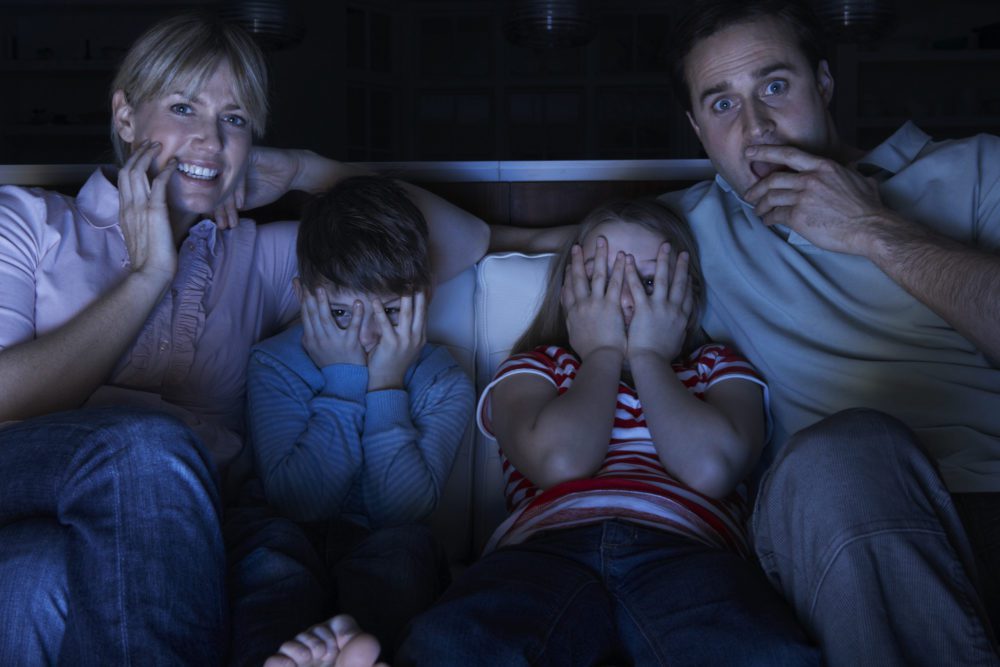Fears & Phobias in Kids, feat. Susan Sprich, PhD – Shrinking It Down

Posted in: Grade School, Multimedia, Podcast, Teenagers
Topics: Anxiety, Child + Adolescent Development
Fears and phobias are not the same thing.
All of us have fears – kids and adults alike. Many of us even enjoy a good scare now and again (there’s a reason why horror movies do so well). And most fears in our children – real or imagined – eventually respond to reassurance, emotional calming, or distraction. But when a fear persists, resisting rational or emotional soothing and creating obstacles in daily life, it becomes a phobia.
Just in time for Halloween, we’re kicking off our new season with a look at specific phobias in kids. We’re joined by special guest Susan Sprich, PhD of Massachusetts General Hospital to learn more about fears and phobias, and to discuss what treatments work best and what parents can do to help.
Media List
- Susan Sprich, PhD (Massachusetts General Hospital)
- Cognitive Behavior Therapy, featuring Susan Sprich, PhD (Spotify)
- Could You Have Samhainophobia or the Fear of Halloween? (VeryWell)
- Types of Specific Phobia (Perlman School of Medicine, University of Pennsylvania)
- Fear of the Dark? 16 Ways to Help Your Child (MGH Clay Center)
- Nature Vs. Nurture, featuring Jordan Smoller, MD, ScD (Acast)
- Treatment – Phobias (NHS)
- How Do You Treat Specific Phobias in Kids? (MGH Clay Center)
- Cognitive Therapy Rating Scale – Revised (CTRS-R) (Beck Institute)
- Involving family members in exposure therapy for children and adolescents (American Psychological Association)
Thanks for joining in this conversation. We’ll see you back the Third Thursday of every month! Subscribe wherever you stream.
Episode Transcript
SPEAKERS: Gene (Beresin); Khadijah (Booth Watkins); Dr. Susan Sprich
Dr. Susan Sprich 0:00
I think the best thing parents can do is just sort of gently encourage kids to do the things that frighten them. So not. I think sometimes as a parent, you know, if parents get frustrated, they may say, oh, what’s the big deal? Like, just do it, you know, and that sometimes can backfire.
[INTRO MUSIC]
Gene 0:28
Welcome back to shrinking it down mental health made simple. I’m Gene Beresin.
Khadijah 0:32
And I’m Khadijah Booth Watkins.
Gene 0:33
And we’re to child and adolescent psychiatrists at the Clay Center for Young Healthy Minds at the Massachusetts General Hospital.
Khadijah 0:40
So we’re kicking off our new season today, just in time for Halloween. [SOUND EFFECT] And we have a very special guest to help us make sense of specific phobias in kids. And so Dr. Susan Sprich, welcome to the show. And thanks for joining us.
Dr. Susan Sprich 0:57
Great to be here.
Gene 0:58
Actually, we should say Welcome *back* Susan. Because Susan joined us a few years back to talk about cognitive behavioral therapy. Something I’m sure will come up again today. And, and I have to say this episode continues to be one of our most listened to. So for those listening, be sure to find it when the MEDIA list for this episode. This was before your time, Khadija.
Khadijah 1:21
I see what you did there, Gene, it’s okay. I’ll get you back. Don’t worry.
Gene 1:26
Anyway, before we get started a little background on Dr. Sprich. She served as Director of psychology training here at Mass General since 2021, and the clinical director of psychology since 2022. She’s also an assistant professor in psychology and Harvard Medical School, Dr. spirituous, co author of numerous chapters and articles on topics including psychosocial treatment for ADHD in adults and adolescents, trichotillomania – that’s hair pulling, for those of you who don’t know – and social anxiety. She served as the lead editor and second editor of the MGH cognitive behavior therapy handbook, published earlier this year. And she’s an associate editor of the journal cognitive and behavioral practice. And she won the American Psychological Association, outstanding contributions to continuing professional development award in 2021. Dr. Sprich has an extreme clinical experience has extensive media that again, Dr. sprach has extensive clinical experience in working with ADHD, anxiety, tactile amania, obsessive compulsive disorder, and other disorders in the OCD spectrums. I could go on. But I’ll stop there. And I’m so honored to have you here today, Susan.
Khadijah 2:45
Okay. So I guess, welcome back, Susan. And I’m gonna bring us back to Halloween [SOUND EFFECT] for just a second. Because this is quite timely. And a lot of folks, you know, young and old, enjoy a good scare from time to time. And I do not include myself in that group, because I do not like to be scared at all. So let me just make that clear. I remember back, almost knocking my son down to get out of a haunted house one year, it was really not my thing. But anyway, I digress. So I want to start off talking a little bit about fear in general. And the role that plays and phobias. Questions that have are what is fear? What happens when our brain is in, I guess, fear mode or afraid? So maybe it’s something that we can all chime in on. But what’s the difference between like a natural, typical fear and what is a phobia?
Dr. Susan Sprich 3:33
Yeah, I mean, I can start to answer that, but definitely chime in. And I think when when we get really concerned about a fear and may start to veer into the realm of phobia, is when it’s, it’s causing interference, so causing people to kind of, you know, not do things that they would otherwise really want to do that align with their values, or when it’s causing them a lot of distress. So when they’re spending a lot of time thinking about it, and it’s really, really upsetting to them, you know, that’s when we would start to start to look at a phobia as opposed to just sort of a natural fear.
Gene 4:19
And, you know, I looked it up there is a fear of Halloween. [SOUND EFFECT] Samhainophobia. I didn’t. It’s a fact. But let me just be more specific. So now that we know what a fear is, there is a big difference of a fear and a phobia. And I think what we wanted to talk about today is specific phobias. So where there is sometimes a legitimate situation that presents a danger, but help us to understand the different situations and let’s start with the basics, just I mean, There are five specific phobias, right? I mean, so there’s, there’s animal, natural environment. And this might be a legitimate one like, you know, mudslides and storms and all the stuff that’s happening with climate change, blood injection injury, and then situational ones, like, airplanes, elevators, you know, so they’re all labels for different specific situations. So, so what’s the experience in each of these specific situations? And, and why would you call it a disorder?
Dr. Susan Sprich 5:34
People — it’s a disorder when people really respond in a way that is extreme, or is sort of out of line with what’s expected, right? So, you know, is anyone going to go jumping in a swamp full of alligators? Probably not. Right? Because that, you know, that there is legitimately a really high chance of getting injured, or maybe killed, in that situation. So that’s not something that any of us would advise. But you know, something like a fear of flying, while there is a very small chance that the plane is going to crash, right, like, planes do crash, occasionally, the on the whole, the cost to always avoiding flying would be much greater than the likelihood that you know that that any given plane is going to crash. So, you know, it’s, you know, people’s response is sort of way out of line with the the likelihood that the feared consequence is going to occur. Does that make sense? Yeah.
Gene 6:45
So what about, what about something that is pretty common? And for young kids, it may be normal, and for other kids who may turn… dark, that — fear of the dark? So what would you have to say about that as a specific phobia?
Dr. Susan Sprich 7:03
Well, again, you know, I think it’s, it’s normal, right? It’s sort of the fear of the unknown, right? You can’t, you know, you don’t know what’s out there in the dark. So things that that may seem perfectly fine in daylight, are a little bit more scary at night, and you just don’t really know you peek out your window, and you can’t see what’s out there. So it’s, it’s frightening. So again, I think it’s, it’s very natural, that, you know, fear of the unknown, you know, difficulty tolerating uncertainty, those, those are very common things that, you know, to varying degrees are difficult for all of us. Right? You know, but just like with other things, you know, you’re not going to advise someone to do something that is objectively dangerous, or you’re not going to tell children or adults to go, you know, out walking in the woods alone, in the middle of the night, or certainly to go walking down a dark alley, by themselves late at night, or something like that, you know, but but with repeated exposures to situations that actually are safe. So like, you know, keeping the closet door open, when children are sleeping or something like that, they will get used to it and stop being so afraid of it.
Khadijah 8:18
I want to talk a little bit more about you with about what causes phobias. And I also want to mention, it’s incredibly common. It’s actually one of the most common mental health conditions that we see in kids specific phobias. So if any parent or caregiver is listening, I really want you to know that if this is something your child is going through, please know that you’re not alone. I mean, it’s nothing to be ashamed of. But I do want to think about or want to ask you, what causes phobias? Or do we even know? They’re so common, but yet there also are many kids that don’t have them.
Dr. Susan Sprich 8:51
Right. That’s a great question. And I think it’s one of those things that there’s not one answer to that question, that sometimes when you when you speak to kids who have fears, they can really pinpoint a particular situation, that, you know, when the fear started, so, if a child is afraid of dogs, they might be able to say, well, three years ago, you know, this happened where either I got really scared by a dog or I got bitten by a dog or, you know, dog jumped up on me or something, and they, they can really target that one event as, you know, the time when, when the fear started. And then there are other situations where, you know, people have fears and they really can’t pinpoint, you know, when it started or why it started or that that even something, you know, they might say, I am really afraid of dogs and, you know, I can’t even think of a time when, when anything happened with a dog. I just, you know, I just feel really, really afraid of them. You know, there’s also some data that anxiety is you genetically transmitted. So if family members have anxiety, kids will be more likely to also exhibit anxiety in some form. So there’s sort of this predisposition, if family members have anxiety, also, there is the role of, of, you know, observational learning that if kids see their parents being particularly worried about particular situations, they, they pick up on that, and they may also feel really worried about that situation. So, you know, if a parent is not, you know, is staying in the basement, anytime there’s a rain drop, and you know, they’re, they’re not going anywhere outdoors, if they think there might possibly be a storm anywhere in the vicinity, you know, children may pick up on that, and also, you know, feel afraid of, of bad weather, or thunderstorms or whatever.
Gene 10:53
So it’s estimated that about one in five, and this is — it’s estimated that one in five kids and adults will have some kind of a phobia. What are the most common ones, in your experience?
Dr. Susan Sprich 11:03
Yeah, so so often, young kids are afraid of things like getting injured or getting kidnapped, they may be afraid of natural disasters, you know, being separated from their parents kind of more of a separation anxiety. Adolescents are often afraid of, you know, kind of large open spaces or being in claustrophobia being in very small spaces. Also things like, hates, or certain types of animals or insects.
Khadijah 11:38
So when should we be worried as parents, you know, what are the signs and symptoms or behaviors or changes in behaviors that would give us cause for concern that this is more than just a typical fear? And we’ve moved in the realm of a phobia? Are there warning signs that we could look out for?
Dr. Susan Sprich 11:58
Yeah, that’s a great question. Because I think as parents, we’re always trying to figure out, you know, when when do we need to be concerned? And when can we sort of let things go and hope that they resolve on their own? You know, I think as we talked about earlier, it really comes down to impairment. So is, you know, is the child missing out on things? Are they are they avoiding things that they otherwise would really like to do? Or they, you know, what they really like to go to overnight camp, but they don’t want to go because they’re worried that they’re going to be bags in the cabin at overnight camp, and, you know, so they’re missing out on a potentially great experience, because of the phobia is it causing them a lot of distress. Are they really, you know, crying every time they think about going on a trip, or, you know, they, they, you forced them to go on this awful trip to Disney World, you know, it’s because they, they, you know, they have to go on a plane. So instead of being excited to, you know, see the characters and go on the rides and, and do all that they’re, they’re really focused on just getting there and how awful it’s going to be to, you know, to go in the airplane for them, and how, you know, while they’re there, rather than enjoying the time, they’re focused on “Oh, my gosh, now I have to get on a plane to go home.” So when when you start seeing the fear, impacting kids enjoyment of things, and also, you know, impacting their decisions, impacting the things that they are choosing to do, and causing them to miss out on things with their friends, or academics or, you know, things family experiences, then I think, you know, you start to think about needing to intervene.
Gene 13:47
And speaking of intervention, what do you do? I mean, I assume that we’re not suggesting the parents. I mean, we can talk later on maybe about what parents can do to support professional help. But could you kind of walk us through, like, as a professional, what your technique would be to treat a specific phobia?
Dr. Susan Sprich 14:11
Sure, um, well, I mean, I’m a cognitive behavioral therapist and a psychologist. So my approach would be to, to use psychosocial treatments rather than medication although that medications are also an option. But with children, what with everybody really was obvious. We would work with them on sort of developing kind of a model. You know, talking with them about this is what we think is happening and, you know, you have this strong fear response, and then it’s causing you to engage in these behaviors. So the behaviors might be avoiding certain situations. They might be seeking reassurance. So sometimes kids will say to their parents “Oh, Can you promise me that this is a safe situation?” And they’ll you know, repeatedly ask for reassurance? They might, older kids might do a lot of research, like, sort of look stuff up on the internet. But, you know, so trying to understand like, what are the situation that the individual is avoiding? How hard would it be for them to kind of face their fear in those situations? Are they engaging in any safety behaviors, and then you would work with them to develop what we call an anxiety hierarchy.
So basically, kind of, it’s kind of a list of different situations ordered from kind of, you know, low to moderate anxiety, on up to “Oh, my gosh, this is kind of the highest anxiety situation I can I can imagine.” So like, do you need to take an example with a fear of dogs, you know, maybe, you know, you mutually use a scale of either 0 to 100, or 0 to 10. So using the 0 to 10 scale, we like to come up with a list of maybe like 10 different situations or more, that range from like, a 3 to a 10? And so you would you would try to get them to identify, like, what are the things that you know, so like, with dogs, maybe if the dogs on a leash, you know, that makes it a lower anxiety, or maybe if if it’s a cute little puppy, that’s, you know, two pounds, it might be lower anxiety than a big German shepherd or something like that. So, you know, thinking about what, what variables would make a situation a little bit easier, a little bit harder. And then you would try to work with the person to start approaching those situations, and to not engage in any kind of like rituals or safety behaviors that might kind of interfere with the exposure.
Gene 16:52
So just for the audience’s sake, I mean, people throw around labels. So back in the old days, they would call this systematic desensitization. And then it became cognitive behavioral therapy. And now it’s exposure response prevention. Now I reason I throw those out there is because when folks go online, they’re going to see all three of those terms. What’s the difference? I don’t know, how do we understand the difference? Are they all the same kind of thing? In terms of kind of gradual exposure and reducing their anxiety at different levels?
Dr. Susan Sprich 17:26
Yeah, I would say, they’re pretty much describing the same thing, where basically, what you’re trying to do is to get the person to face their fears. Right? And to, to and to improve their learning. So they’re going to learn that. So what happens, what we think happens and in phobias is that people, they, they become fearful. And then when we become fearful of something, our natural instinct is to avoid it. Right? So like, again, to think the dog, the dog phobia, examples, a good one. That’s an easy one to relate to. Where if I decide, you know, maybe I have a bad experience with a dog, or maybe I don’t, maybe I’m just like, afraid of dogs. And but I kind of have it in my head, that dogs are scary, dogs are dangerous. If I get around, if I go around a dog, something bad’s gonna happen, right? They might bite me, they’re gonna jump on me they, you know, they’re, it’s not a good situation. And then because I have that fear, I started avoiding any situations where I might encounter dogs, right, so I don’t have a dog, I maybe if I go to my friend’s house, I asked them to keep their dog locked up in the kitchen so that I’m not going to be near it. When I go to the when I go for a walk, I cross the street before I go by the dog park. So I’m not, you know, not near any of the dogs. So that maintains my fear, right? Because I’m not near any dogs. So I never get the chance to learn any different. Right? To learn that some you know, most dogs are fine, most dogs are, are cute, even if they jump up on me, they’re, they’re not going to hurt me, they’re just maybe going to get some mud on my outfit or you know, slobber on me or something. But you know, but nothing, that thing really dangerous is going to happen. So it sort of keeps that that cycle going. So what we need to do is to give people new learning opportunities to see that oh, like I was around my friend’s dog and I was able to pet them and yeah, maybe they, you know, snapped at me or they licked me or like, you know, something, but, but nothing terrible happened. Right? So we want to start giving people new opportunities to expose themselves to these these avoided or feared situations and then learn that the feared outcome isn’t going to happen.
Khadijah 19:48
You know, it can be hard as a parent to to know what to expect when you see something in terms of like, what the course is. You know, we often find ourselves thinking you know, is this a phase? Will it pass? But when we have kids that have specific phobia and meet the criteria that you kind of describe where there’s tremendous suffering or impairment, is it reasonable to think that most kids will just grow out of it? If we leave them alone and do nothing, will it kind of get better over time on its own?
Dr. Susan Sprich 20:17
I think depends, right? I’m sure for some kids, it, that will happen. And also, it may sort of happen naturally, like, maybe they may, you know, have a best friend that has a cute little puppy. And so they end up spending time with that puppy, and then they realize that maybe dogs aren’t so bad, or maybe, you know, their desire to go to overnight camp, outweighs their fear that there might be bugs in the wilderness, and they, you know, they go and then they, they get a chance to see for themselves. So I think many times it does happen by but then, you know, other times, if that fear, you know, just keeps keeps festering, and, you know, it may continue, and you may decide, at some point that they need professional help, or you know, some kind of intervention.
Khadijah 21:13
And no one wants to see their child, their loved one suffer, is there anything that we can do, as caregivers, as parents at home to support our children who are struggling with or dealing with phobias, maybe even as an augmentation, or support to their other treatment?
Dr. Susan Sprich 21:30
Mmhm. I think the best thing parents can do is to sort of gently encourage kids to do the things that frighten them. So not. I think sometimes, as a parent, you know, if parents get frustrated, they may say, oh, what’s the big deal, like, just do it, you know, and that sometimes can backfire. But sort of gently encouraging them to face the situations that are challenging for them, I think modeling for them, so if if you can model, you know, I don’t feel totally comfortable in this situation, but I know it’s not dangerous. So, you know, I’m gonna go on the airplane. Anyway, because it’s really important for me to, you know, go on this family vacation, even though I don’t feel totally comfortable flying. So things like that, I think, you know, can really be helpful.
Khadijah 22:19
And so gently would not be, let’s go to the dog park. That would not be gently?
Dr. Susan Sprich 22:26
Um, I mean, I think you want to, you want to sort of collaboratively decide on goals. So I think any, you know, for any of us, if if somebody sort of forces us, and even if I said, “Oh, I really want to overcome my fear of dogs.” And then you said, “Okay, I’m your friend, like, I’m gonna drag you to the dog park and like, lock you in there,” I probably wouldn’t appreciate it. Right. So. So just, you know, like, I think this would be a good way, you know, the conversations that we have with kids around this stuff are very much sort of collaborative discussions. Like, this is what I think is going to be helpful for you, what do you think is a step that, you know, a first step that would work for you, or that you’d be able to do? You know, if you if you kind of, you know, push too hard? Sometimes it can, you know, it can backfire? It can kids can if you if you took the child to the dog park and dropped them off and left them in there, and they’re really frightened, and they’re, they’re crying and they’re, you know, running around and whatever, that’s, that’s not going to be a good exposure exercise for them. And it’s probably not going to help their them overcome their fear.
Gene 23:37
And by the same token, What should parents not do? Like, an obvious example would be like, like, “Watch out, the boogey man is going to get you — have a nice night! Hehehe.” I mean, that’s an exaggeration. But you know, parents might not take it as seriously, or they might joke about it. I mean, inadvertently, I mean, no parent wants to harm their kid. But I mean, are there things that you would advise parents to kind of avoid doing rather than just being supportive? And, and knowing what the what the what the exposure response plan is?
Dr. Susan Sprich 24:16
Yeah, no, no. That that’s a good, It’s a good question. I hadn’t even thought of that one Gene. But definitely not trying to scare their children. But I would say actually, the, the things that, that I find the most when working with, with parents of kids with anxiety, is that they try to be too kind, you know, they, they worry they don’t want their their child to feel uncomfortable. And so they allow, allow avoidance allow escape from situation. So if a child feels really anxious, they, you know, swoop in and sort of remove them from the situation. which I think, you know, so many times is just very loving and well meaning and like my, my child, you know, doesn’t feel comfortable at this barbecue, because, you know, there’s some clouds in the sky, and they really worried about thunderstorms. So I’m just going to take them home where they feel safe, right, which, you know, in the moment is such a loving and kind thing to do. But then the message that it sends to children is like, “You’re not really safe.” Like, “I don’t I as your as your mother, as your father, your parents, you know, don’t think that it’s safe for you to stay at this, this cookout, because there’s, there’s some clouds, and there might be rain or maybe potentially, a thunderstorm.” And so it sort of sends, you know, inadvertently sends a message that, you know, your your phobia is like, right on, right on target and you, you can’t be outdoors.
Gene 25:52
So so the one mistake that’s apart from my kind of over the top exaggeration, is that, that parents, because they love their kids so much, and they want to protect them, they’re over protective. That being said, is the treatment of necessity one That one does in reality in real time? Or can you do this online? I mean, do you as a therapist have to go out to the house? And, and conduct the exposure response prevention? Do you teach the parents how to do it? You know, do you use online ways of doing it? So what are the practicalities? Because I’m sure that a lot of parents out there gonna say, okay, my kids got this phobia? Who’s Who’s going to come out of this house and guide me through it? What’s going to happen?
Dr. Susan Sprich 26:42
That’s a good question. I mean, I think there are a lot of good resources for parents. There are some workbooks. There’s, you know, online resources. So certainly, before going to a professional, you know, that’s not a bad thing to try there. Even for very young kids, there’s some sort of picture books that talk about tools that kids can put in their toolbox and, and so forth. So, you know, depending on the age, I think there are, there are a lot of resources that are pretty well suited to kids of many different ages, even very young children. When people are, you know, obviously, depends on the phobia. So some things are more easily, you know, brought into the office than than others. So, you know, something like, you know, a, an insect phobia or something, you know, you can get little plastic plastic insects or make spider cookies, or have you know, that with your discussion of Halloween, Khadijah. You know, I think there are a lot of opportunities actually to, to sort of take something that could potentially be scary and say, great, you know, what a good opportunity, like, you don’t like spiders, like, my gosh, there’s so many spiders from, you know, you know, climbing on people’s houses. And, you know, we have spider costumes and spider, you know, this and that for Halloween, let’s take advantage of that, like, this is a really great time for you to practice facing that fear, because there’s so many opportunities out there. But so, you know, some things you can bring to the office, sometimes with virtual visits, you can, you know, it’s actually nice. So, maybe somewhat with phobias, but also with things like OCD, when people have their, you know, rituals that they do that involve things in their home, it’s actually easier to do it on video, because you can say, okay, like, so go over to your sink, and, you know, bring me with you and your iPad, and let’s let’s do it together. So, you know, so I don’t think you necessarily need someone to go out to the house occasionally. You know, people will do home visits when it’s when when it really seems like it’s indicated.
But, you know, usually what I do is do you know, work on the hierarchy and sort of come up with a hypotheticals in the office, I always either have parents involved in that discussion, depending on the age of the child, but with, you know, even with teenagers, usually, we bring the parents in at some point. So I may have the conversation with the teenager, that just by themselves, but then we bring the parent in and we, we share with them what you know, what the assignment is, like, this is what the child is going to do, and talk with parents about how they can support that endeavor. So what you know, what they should do, how, how they can support their child and, you know, often I find that parents are very grateful to be included and to have specific instructions about how they should help. And also kids are really, really grateful to have that discussion and to be able to say, “Well, like it helps me when you do this, but not so much when you do that.” So, “Like when you make that monster noise you know, that doesn’t really help me. But when you you know, just leave the door open a crack but don’t come all the way and you know, whatever, that makes me feel better. Like, that’s a good middle ground and I think that would be a good next step.”
Gene 30:01
So there’s a parent question. Okay. “My nine year old son developed an intense fear of bees this past year, all kinds of bees, including wasps and Hornets, but there were also Bumble and honey bees, and he’s never been stung before. And we’re not sure why it was so bad this summer that he stayed inside for most of the family cookouts.” Well, let me give you an example of that. And I’m an avid gardener and I have I buy plants to attract butterflies and honey bees and bumblebees. And my grandchildren who are pretty young, they know that bumblebees and honeybees are really very docile and friendly, and they can actually approach them. This summer, we were out in the Catskills and we were at a diner with during our breakfast, we were kind of swarmed by yellow jackets. And you know, we shooed the kids away, and then literally captured a whole bunch of them under cops. And then we brought the kids back, and we said you safe now, but you see this, see this what this thing looks like? This is called the yellow jacket. And those are the things that you need to stay away from because they’re not like the bees and grandpa’s yard, which are actually quite safe and friendly. And so what do you what do you think about that? As far as an approach, Susan?
Dr. Susan Sprich 31:27
I think it’s a good approach. Yeah. Because I think what you’re doing is you’re providing education, right? So it’s not this all or nothing thing that all insects are bad or all be like creatures or are bad or dangerous, right? You’re, you’re, you’re telling them, you’re teaching the children that most bees are fine, and the bees and grandpa’s yard are good, and they’re healthy, and they’re helping the flowers. And, but that when you see this type of insect, you know, they can, they can be harmful. So you want to stay away from them. So you’re teaching them to differentiate that it’s not sort of an all or nothing thing, but you know, but but there are certain certain times when when they need to be cautious around insects.
Khadijah 32:11
So what about when our support efforts don’t go the way that we were planned. So like, let’s say, they get, you know, scratched by this dog, or they get stung by this bee when we’re encouraging them to go to this picnic or to, you know, pet this little puppy. And so that kind of reaffirms, for them that that any place with bees are not safe or any all dogs are dangerous. How do we recover from those instances? I guess if that makes sense.
Dr. Susan Sprich 32:42
Yeah. Yeah. No, that’s a good question. And I think that happens, and I don’t think the message is, like, bad things never happen. Or like, you know, when you’re with a dog, you’re never gonna get scratched or licked or like, you know, whatever. But, but more, you know, even if that happens, like, is it something you can handle, right, so even if, you know, like: little puppies have claws you make, you might get poked, you might get you know, they, they like to buy things, they might mistake your arm for a dog chew or something. So, you know, but even if that happens, it’s it’s manageable. You know, like, it’s the fear is this big. And what actually happens is, is that big. And also, like I said, at the very beginning, we’re not going to encourage anyone to do things that we objectively think are really dangerous, right? So, you know, if there’s a dog down the street that we know, has a history of biting people and you know, we don’t feel comfortable being around ourselves. Like we’re not gonna even put that dive on the table as a, as an option for the exposure exercise.
Gene 33:57
So thanks again, Susan, for joining us today. By the way, is there anything that we didn’t talk about that would be important for parents or for young people themselves to know about specific phobias?
Dr. Susan Sprich 34:10
I think we did a good job of covering all the aspects of it. I mean, yeah, I think it can be a tricky issue, because everybody has fears. And you know, it’s really a question I think of magnitude of interference of, you know, if that fear is getting so big, that it’s really causing problems. It’s causing the person to feel really distressed, it’s causing them not to do things that they otherwise would want to do. That’s when it might be time to really take a hard look at it and develop a plan. Whether it’s something you start off with by just educating yourself reading stories, getting a workbook or something. Or if you feel like it’s time to seek professional help to help you learn tools, tools to get over it.
Gene 35:02
And of course, life complicated because sometimes phobias don’t occur in a vacuum. They occur in line with depression or a learning disability or, you know, an anxiety disorder of another kind. And they might require a bit more complex management, from psychology and from psychiatry, even with the use of judicious use of medications. So that’s when professional help can really help sort those things out, I think.
Dr. Susan Sprich 35:30
Absolutely.
Khadijah 5:35
This has been incredibly helpful. And we hope we thank you for coming. And we hope for all of you listening that this was also you found this also to be informative and helpful conversation. But to wrap up and to end on a positive note. Is there anything or is there something in particular you’re looking forward to over the next week or so Susan?
Dr. Susan Sprich 35:51
I am going to a little yoga weekend this weekend. So I’m looking forward to that.
Khadijah 35:58
Oh my, that sounds really nice.
Dr. Susan Sprich 36:02
Well, thanks, everybody. And don’t forget, for those of you listening that new episodes come out every Thursday – the third Thursday – not every Thursday. I wish they came out every Thursday because this is so much fun. But on the third Thursday of every month, please subscribe wherever you stream. And if you feeling generous, please leave us a review. And we hope that our conversation helps you have yours. Hi, I’m Gene Beresin.
Khadijah 36:31
And I’m Khadijah Booth Watkins. We’ll see you next time.
[OUTRO MUSIC]
Khadijah 36:40
I feel like I hear he’s telling me that I need to face my fears and go back to that haunted house. [SOUND EFFECT] But we can talk about that offline.
Episode produced by Sara Rattigan
Music by Gene Beresin

 Share
Share Tweet
Tweet







